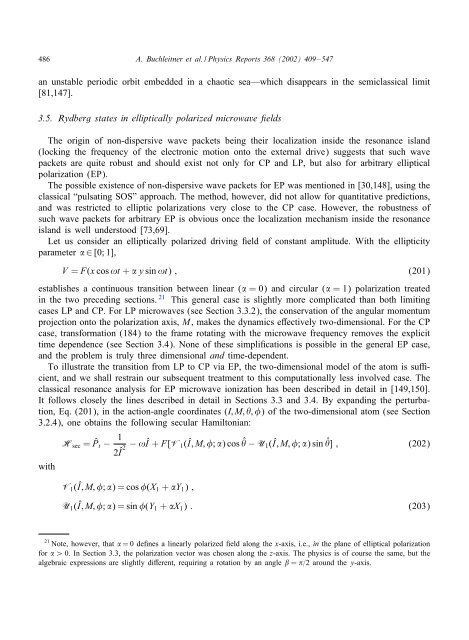Non-dispersive wave packets in periodically driven quantum systems
Non-dispersive wave packets in periodically driven quantum systems
Non-dispersive wave packets in periodically driven quantum systems
You also want an ePaper? Increase the reach of your titles
YUMPU automatically turns print PDFs into web optimized ePapers that Google loves.
486 A. Buchleitner et al. / Physics Reports 368 (2002) 409–547<br />
an unstable periodic orbit embedded <strong>in</strong> a chaotic sea—which disappears <strong>in</strong> the semiclassical limit<br />
[81,147].<br />
3.5. Rydberg states <strong>in</strong> elliptically polarized micro<strong>wave</strong> elds<br />
The orig<strong>in</strong> of non-<strong>dispersive</strong> <strong>wave</strong> <strong>packets</strong> be<strong>in</strong>g their localization <strong>in</strong>side the resonance island<br />
(lock<strong>in</strong>g the frequency of the electronic motion onto the external drive) suggests that such <strong>wave</strong><br />
<strong>packets</strong> are quite robust and should exist not only for CP and LP, but also for arbitrary elliptical<br />
polarization (EP).<br />
The possible existence of non-<strong>dispersive</strong> <strong>wave</strong> <strong>packets</strong> for EP was mentioned <strong>in</strong> [30,148], us<strong>in</strong>g the<br />
classical “pulsat<strong>in</strong>g SOS” approach. The method, however, did not allow for quantitative predictions,<br />
and was restricted to elliptic polarizations very close to the CP case. However, the robustness of<br />
such <strong>wave</strong> <strong>packets</strong> for arbitrary EP is obvious once the localization mechanism <strong>in</strong>side the resonance<br />
island is well understood [73,69].<br />
Let us consider an elliptically polarized driv<strong>in</strong>g eld of constant amplitude. With the ellipticity<br />
parameter ∈ [0; 1],<br />
V = F(x cos !t + ys<strong>in</strong> !t) ; (201)<br />
establishes a cont<strong>in</strong>uous transition between l<strong>in</strong>ear ( = 0) and circular ( = 1) polarization treated<br />
<strong>in</strong> the two preced<strong>in</strong>g sections. 21 This general case is slightly more complicated than both limit<strong>in</strong>g<br />
cases LP and CP. For LP micro<strong>wave</strong>s (see Section 3.3.2), the conservation of the angular momentum<br />
projection onto the polarization axis, M, makes the dynamics e ectively two-dimensional. For the CP<br />
case, transformation (184) to the frame rotat<strong>in</strong>g with the micro<strong>wave</strong> frequency removes the explicit<br />
time dependence (see Section 3.4). <strong>Non</strong>e of these simpli cations is possible <strong>in</strong> the general EP case,<br />
and the problem is truly three dimensional and time-dependent.<br />
To illustrate the transition from LP to CP via EP, the two-dimensional model of the atom is su -<br />
cient, and we shall restra<strong>in</strong> our subsequent treatment to this computationally less <strong>in</strong>volved case. The<br />
classical resonance analysis for EP micro<strong>wave</strong> ionization has been described <strong>in</strong> detail <strong>in</strong> [149,150].<br />
It follows closely the l<strong>in</strong>es described <strong>in</strong> detail <strong>in</strong> Sections 3.3 and 3.4. By expand<strong>in</strong>g the perturbation,<br />
Eq. (201), <strong>in</strong> the action-angle coord<strong>in</strong>ates (I; M; ;<br />
3.2.4), one obta<strong>in</strong>s the follow<strong>in</strong>g secular Hamiltonian:<br />
) of the two-dimensional atom (see Section<br />
Hsec = ˆPt − 1<br />
2Î 2 − !Î + F[V1(Î; M; ; ) cos ˆ − U1(Î; M; ; ) s<strong>in</strong> ˆ ] ; (202)<br />
with<br />
V1(Î; M; ; ) = cos (X1 + Y1) ;<br />
U1(Î; M; ; ) = s<strong>in</strong> (Y1 + X1) : (203)<br />
21 Note, however, that = 0 de nes a l<strong>in</strong>early polarized eld along the x-axis, i.e., <strong>in</strong> the plane of elliptical polarization<br />
for ¿0. In Section 3.3, the polarization vector was chosen along the z-axis. The physics is of course the same, but the<br />
algebraic expressions are slightly di erent, requir<strong>in</strong>g a rotation by an angle = =2 around the y-axis.











